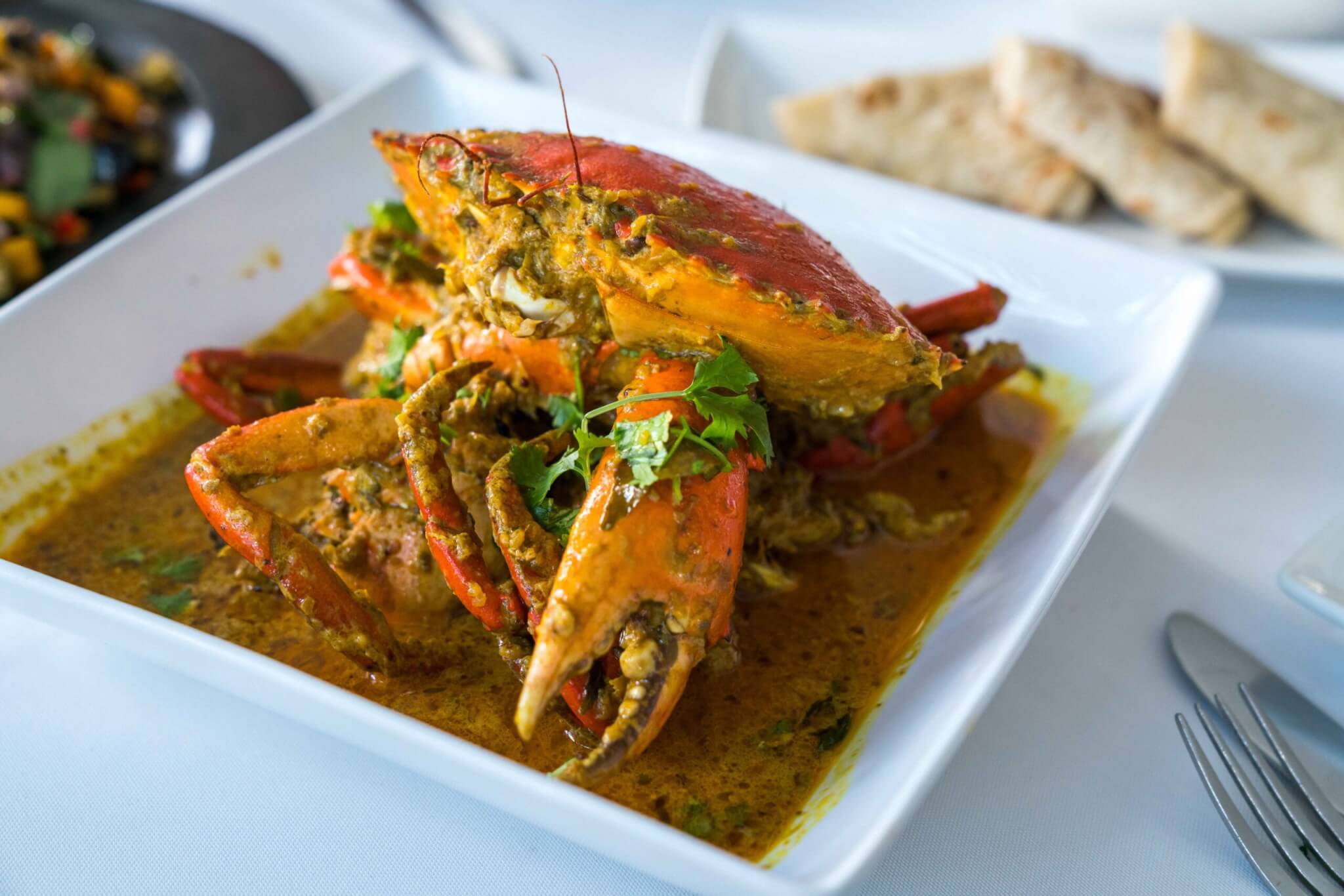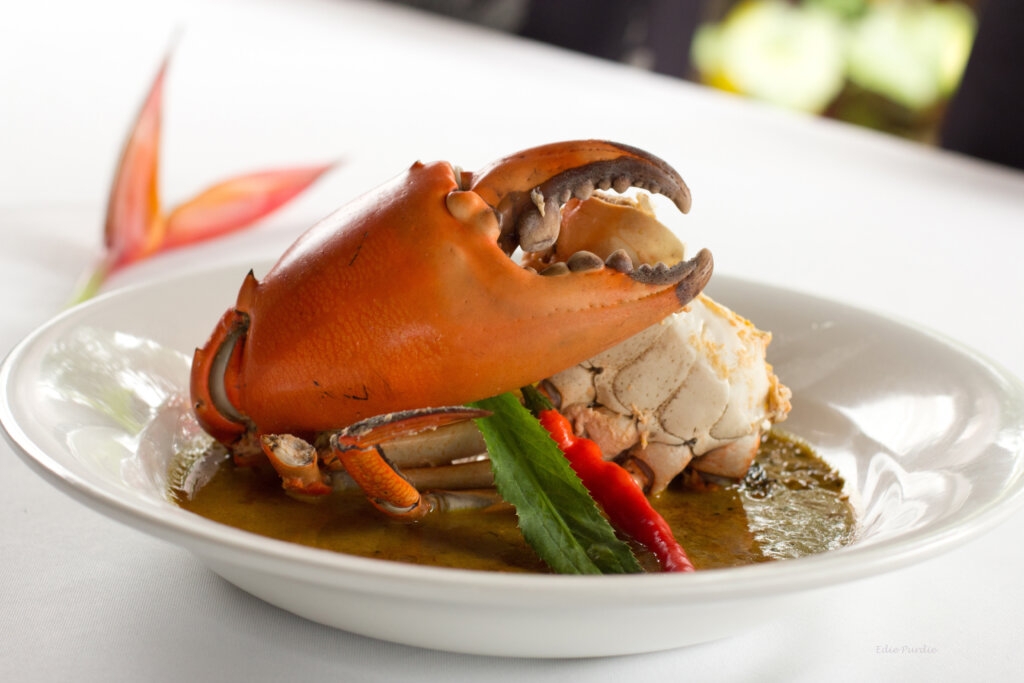Dine
Childhood Memories – Fiji Mud Crab Curry
Suva dining institution Eden keeps its menu fresh in both ingredients and culinary origins. Owner Sangeeta Maharaj reminisces fondly about a dish from her childhood which she loves cooking and sharing with friends and family.
January 25, 2024
Pacific Island Living
January 25, 2024Mud Crabs, (qari)- This seafood delicacy is considered as one of the tastiest of all crab species or possibly all crustaceans. Cooked with Indian spices, fresh herbs and fresh coconut cream makes mud crab curry one of the most delicious food.
I grew up in Lawaki Village, Saweni. The mangroves and sea were our backyard hence our village was a place synonymous with mud crabs. My mother ran a grocery store and the village ladies lined up in front of the grocery store selling strings of mud crabs. At the end of the day any unsold crabs were offered to us at seriously discounted prices. Being the eldest I did most of the cooking so I had the joy of cooking crabs at least once a week. Practice makes perfect!
Sharing a big pot of mud crab at a table filled with family and friends has always brought me so much joy. It remains one of the most popular dishes at my homestay and the restaurant.
MUDCRAB FACTS
Mud crabs are found in estuarine waters and among mangroves. In their most common form, the shell colour varies from a deep, mottled green to very dark brown depending on the environment.
In Fiji it is illegal to sell crabs whose carapaces are less than 12.5cm. Female crabs are not restricted.
Suva Market on a Saturday has an impressive array of seafood including mud crabs costing from FJ$25 to FJ$100 each depending on size and weight. An average crab would be 700 grams and costs about FJ$35 dollars. The moon phase, weight and size are all factors to consider when buying these crabs.
Always buy crabs that are alive. Our Fiji Mud crabs are tied with cloth or forest vine so they are safe to handle. Test by touching the antenna and you can see eye movement or pinch the walking legs.
Crabs moult their shells during normal growth cycles. Crabs that have recently moulted will be empty of meat. They will look clean, have a semi-transparent shell and no wear on claw teeth. They will also be light in weight as they do not have high meat content and their shells will be soft.
As juveniles, male and female mud crabs are difficult to tell apart but it gets easier as they mature. The abdominal flap of females is much broader than that of males and becomes heavily pigmented when the female reaches maturity. Another difference is the claws, which are much larger in males. Australians call females ‘jennies’ and males, ‘bucks’.
For male crabs firmly press the abdominal plates adjacent to the 2nd walking legs or the pincers, for female crabs, press on the carapaces behind the eyes. If there is no flex the crab is likely to be full of meat.
CHEF’S NOTES
We only use fresh coconut milk by scraping dry coconuts. For each cup of grated coconut add ¼ cup water and blend. Using a tea-towel / cheesecloth squeeze the coconut flesh and extract the milk. If using packet coconut milk / cream, check the consistency. We do not want thick cream or runny milk. To thin out coconut cream, add1/3 cup water to 2/3 cup coconut cream.
Eden is located near the American embassy, on the corner of Bureta and Maharaj Streets, Suva. Bookings are required most nights.

FIJI MUDCRAB COCONUT CREAM CURRY
INGREDIENTS
- Live mud crab (about 1kg – 2 crabs) cleaned.
- The innards and eggs / roe , whisked to break it up.
- 80 ml (1/3 cup) canola oil
- 1 large onion, finely diced
- 1 tablespoon grated ginger
- 6 garlic cloves, crushed
- 3 Tbs grated fresh turmeric or 1 teaspoon dry turmeric powder
- 1 teaspoon brown mustard seeds
- 1 teaspoon cumin
- 2 tablespoon masala (Indian spice mix)
- ½ cup canned tomatoes chopped
- 2 curry leaves
- ½ cup fresh coriander leaves and stems chopped
- 4 cups fresh thick coconut milk (Refer note)
- Salt to taste.
- Chillies as preferred.
METHOD
- Kill the crab humanely, place crab in freezer to render insensible (30-40 minutes). Place a skewer in each eye pointing towards each other so the nervous system is killed.
- Scrub the crabs under running water to remove any mud on the shell.
- Place crab upside-down on a board and lift the tail, pull away from the belly, then turn crab over and remove top shell. Be careful to save all of the liquids from inside—sweet oceanic nectar. The innards cling to the edges inside the shell. Remove the intestine sac and then put your index finger and remove all the innards into a bowl.
- Pull away the long grey gills (dead man’s fingers) and discard. Remove large claws with a cleaver or heavybladed knife, then half the body piece.
- Heat oil in a large saucepan over medium-high heat. Add onion, mustard and cumin seeds and stir until they begin to pop. Add masala, turmeric, curry leaves and cook until aromatic (2-3 minutes). Add tomatoes, garlic, ginger, chopped coriander and cook until you can see the oil separating.
- Add the roe and eggs. Stirring continuously to ensure that the roe and eggs are mixed into the sauce.
- Add crab and stir to coat. Cover and cook for 5 minutes until the crab turns red. Add ¼ cup of water if the sauce dries up.
- Add coconut cream, bring to the boil, then reduce heat to medium and simmer until crab is just cooked . Add a handful of coriander leaves.
Serve in a bowl with roti or rice.
© 2024 Pacific Island Living Magazine all Rights Reserved
Website by Power Marketing